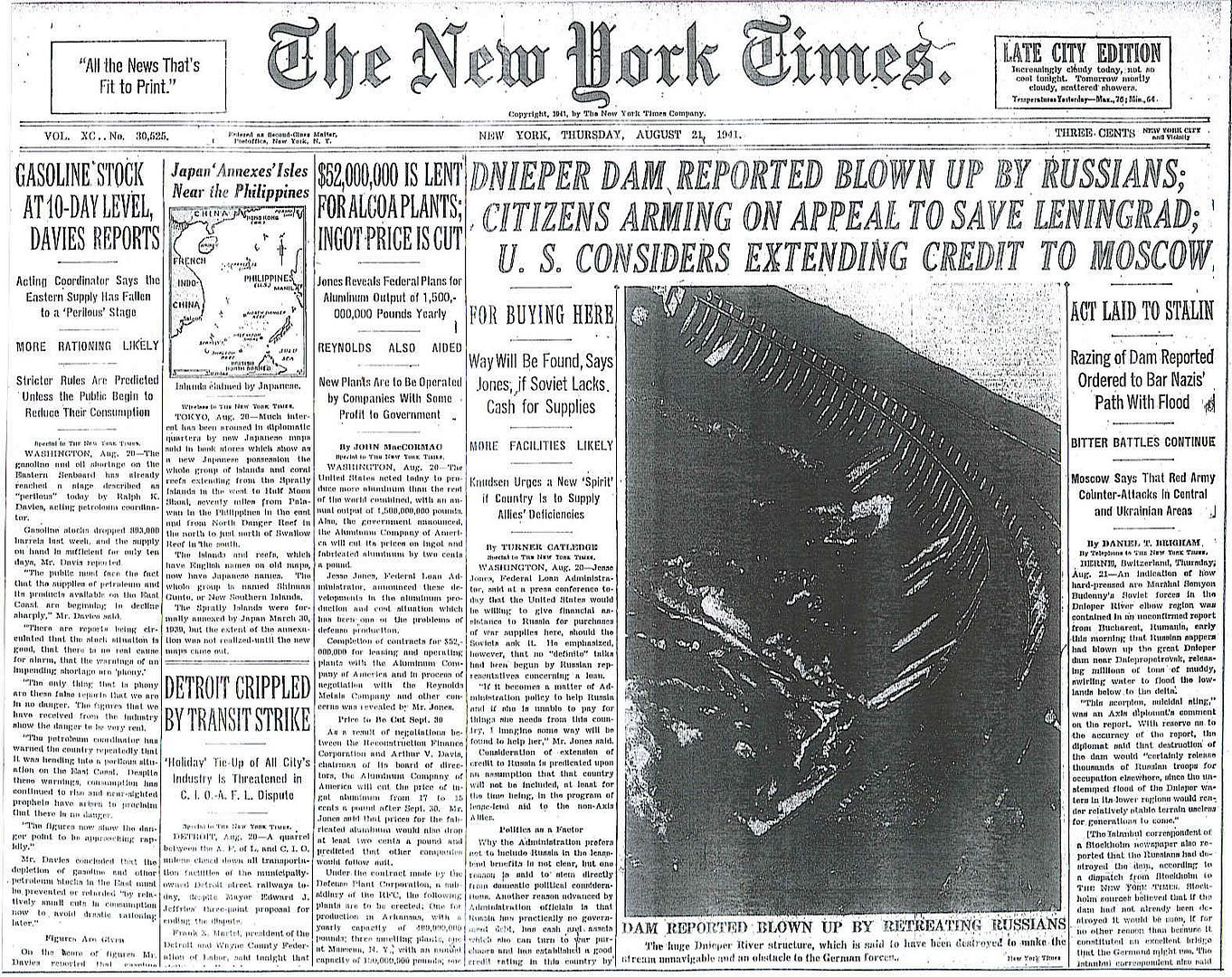
Posted on 08/21/2011 5:14:33 AM PDT by Homer_J_Simpson

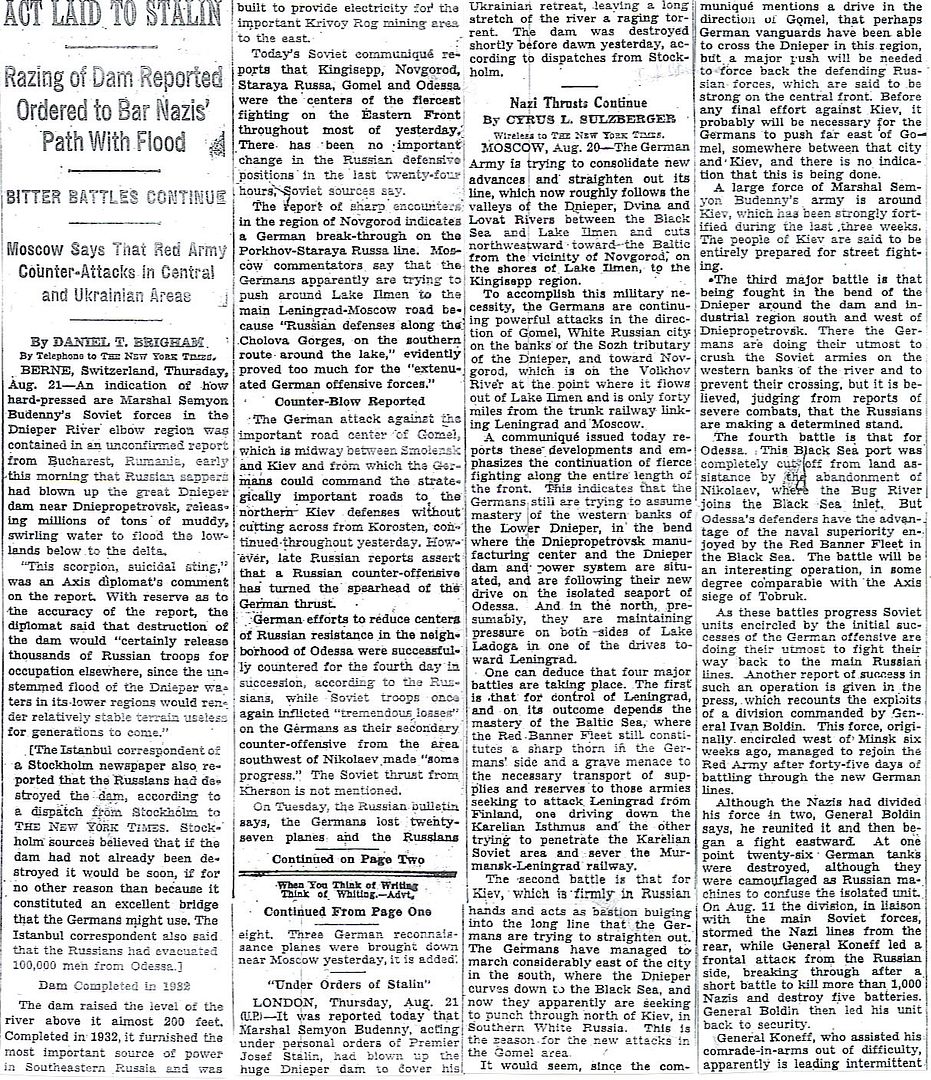
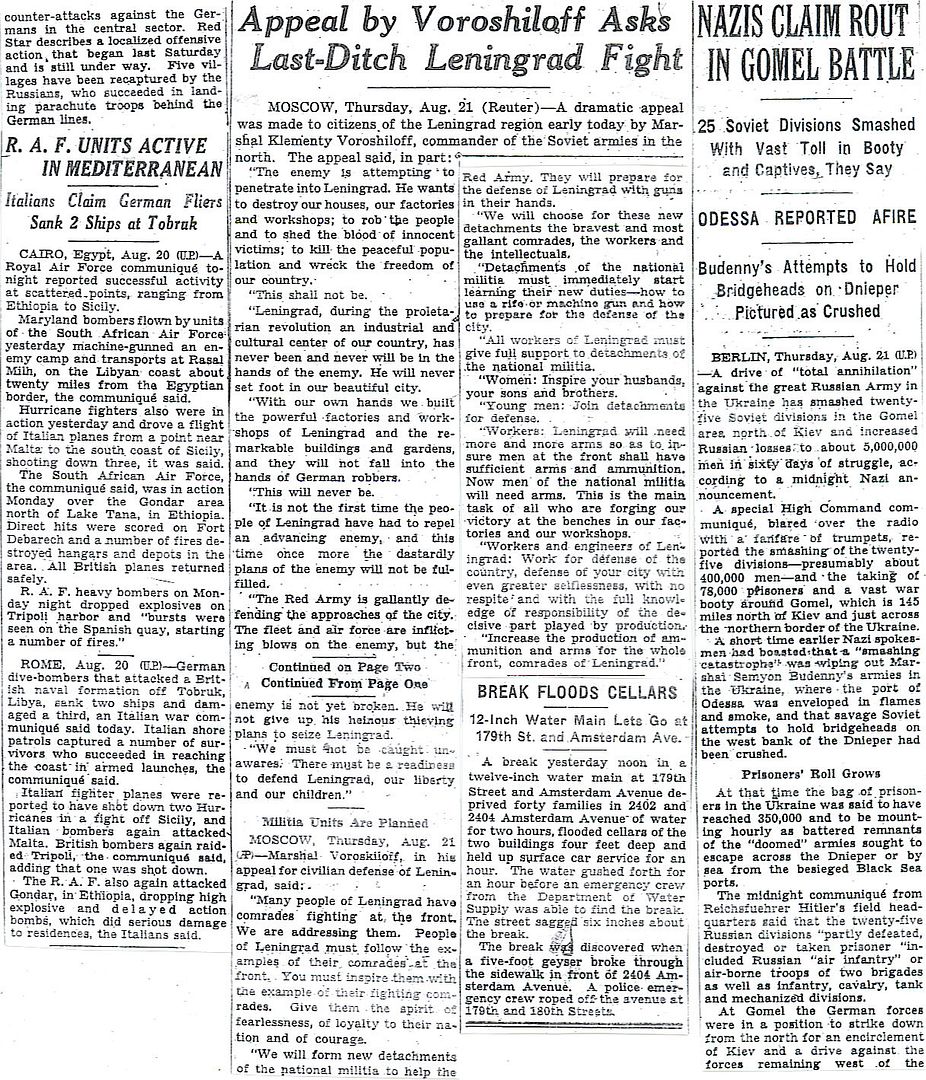
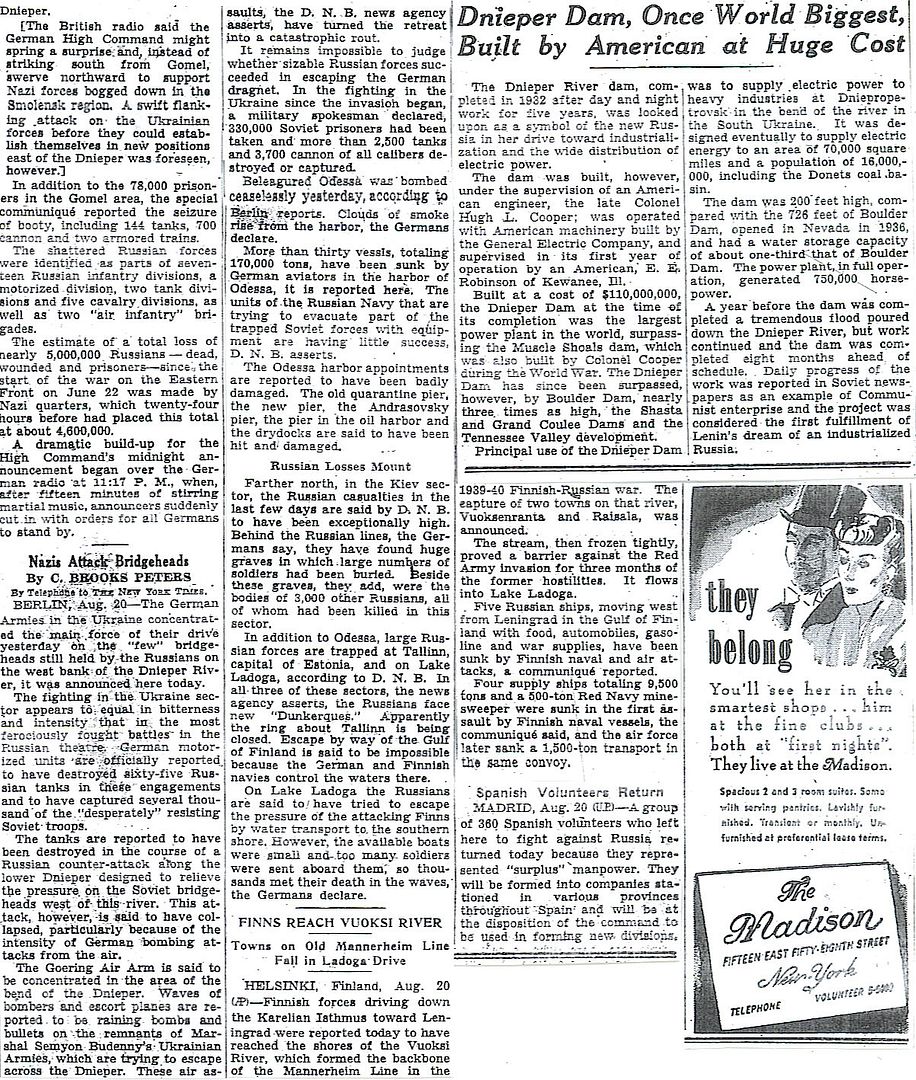
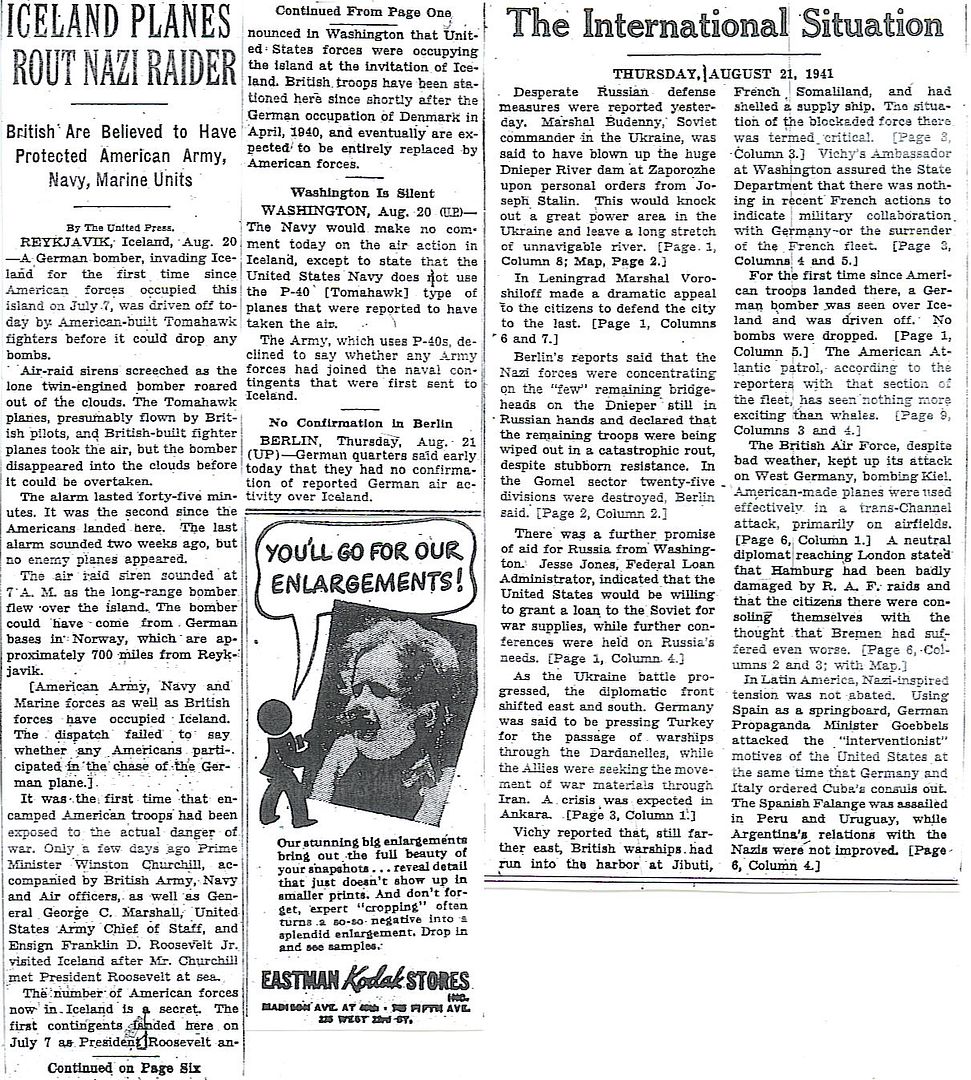
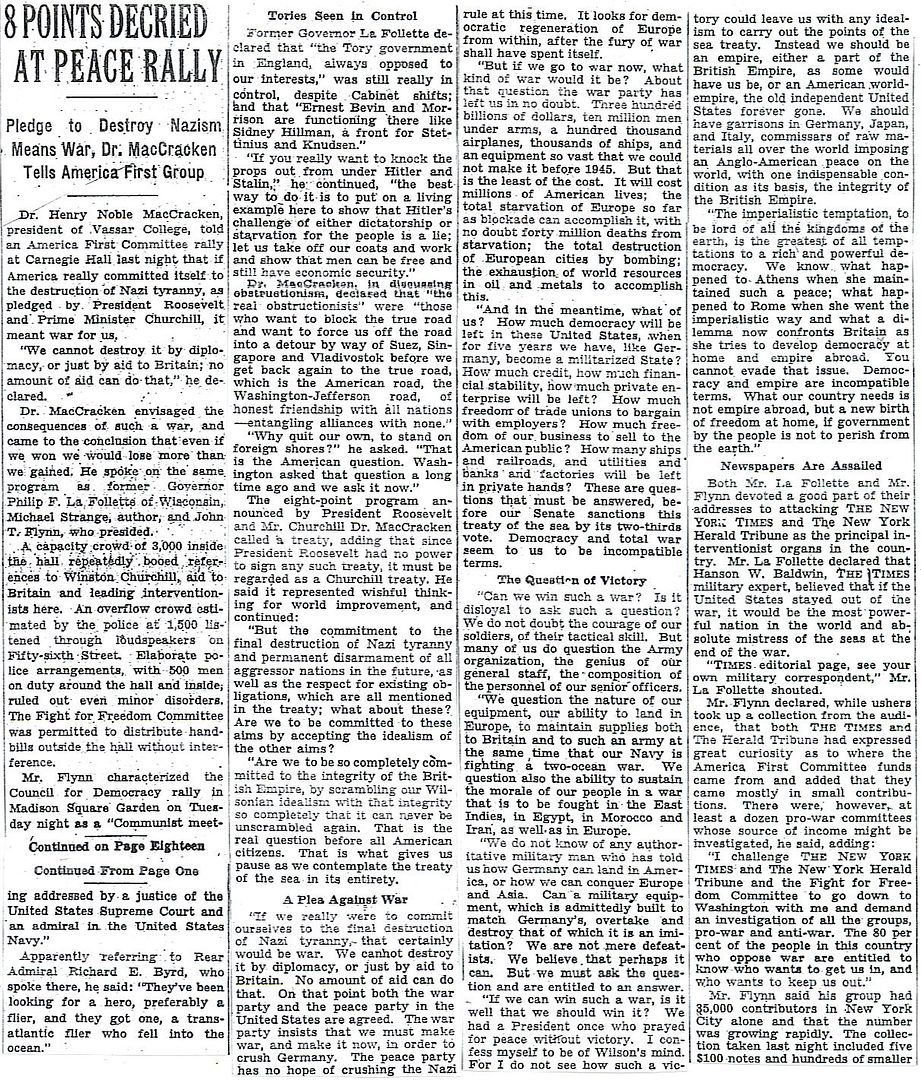
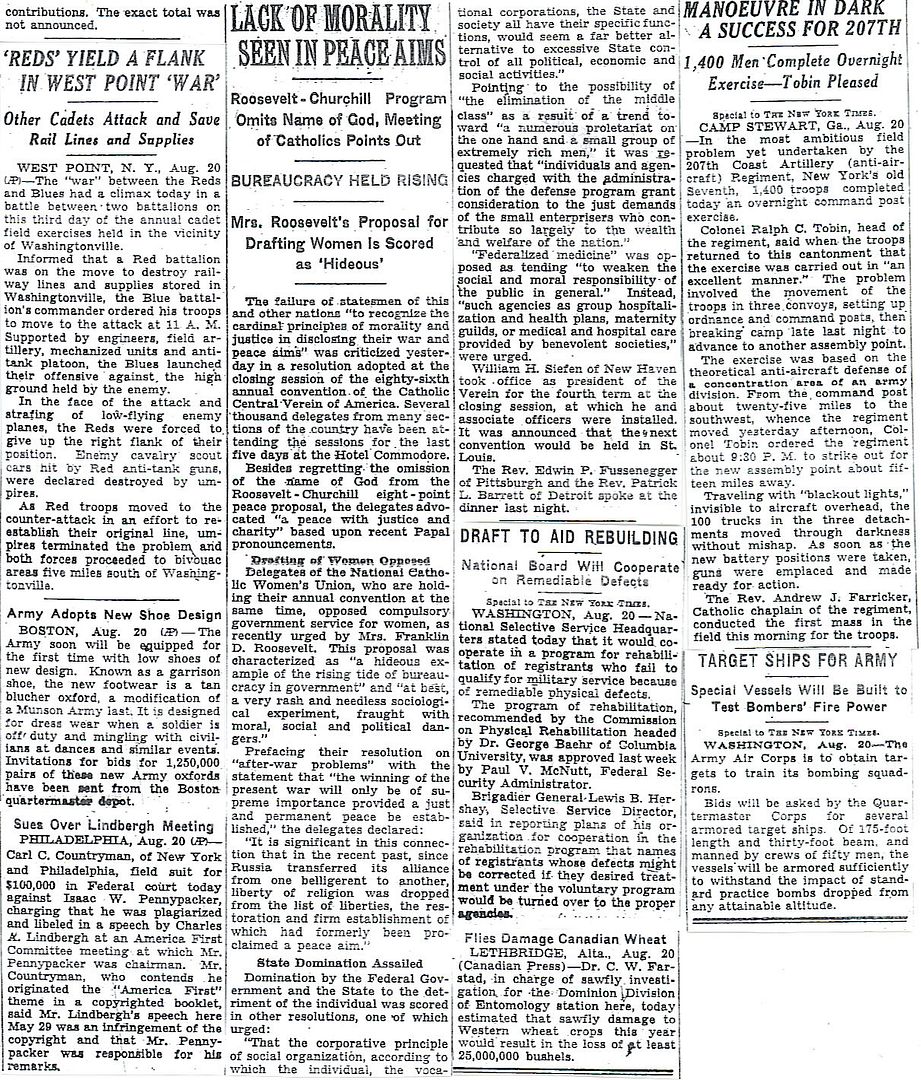
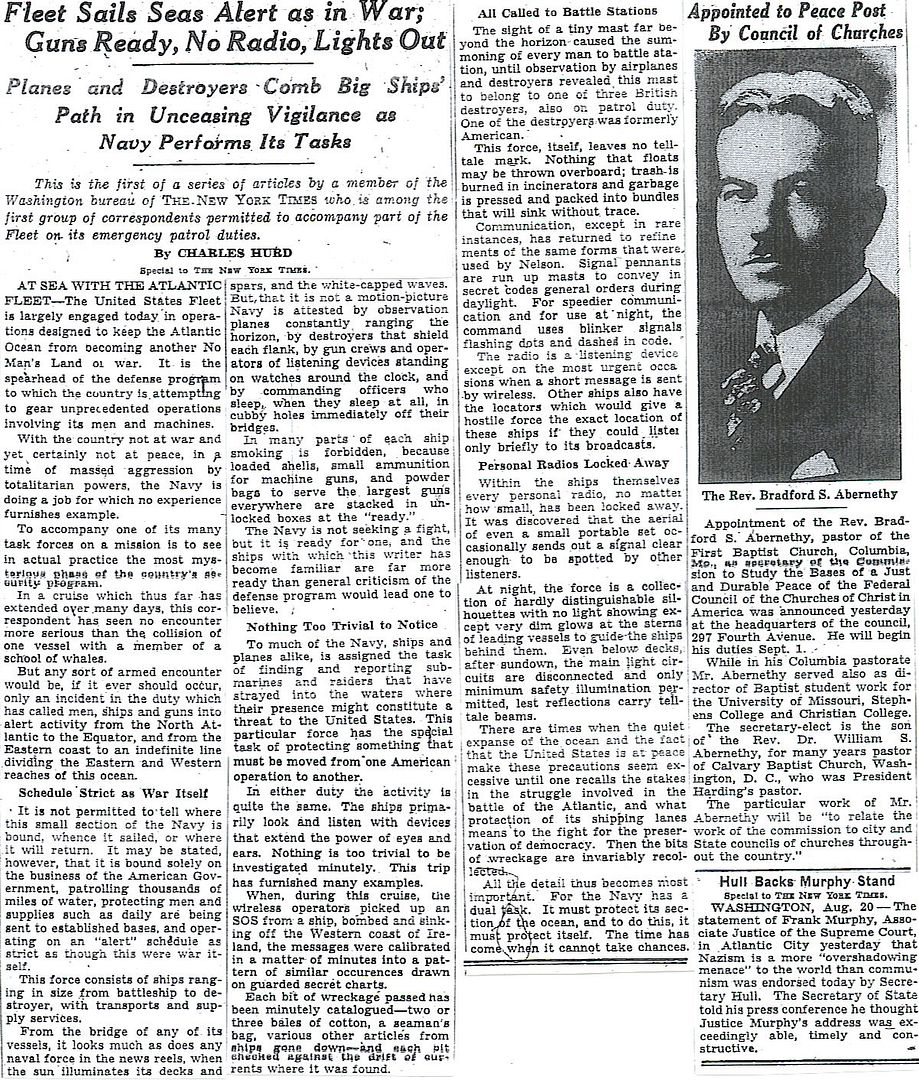
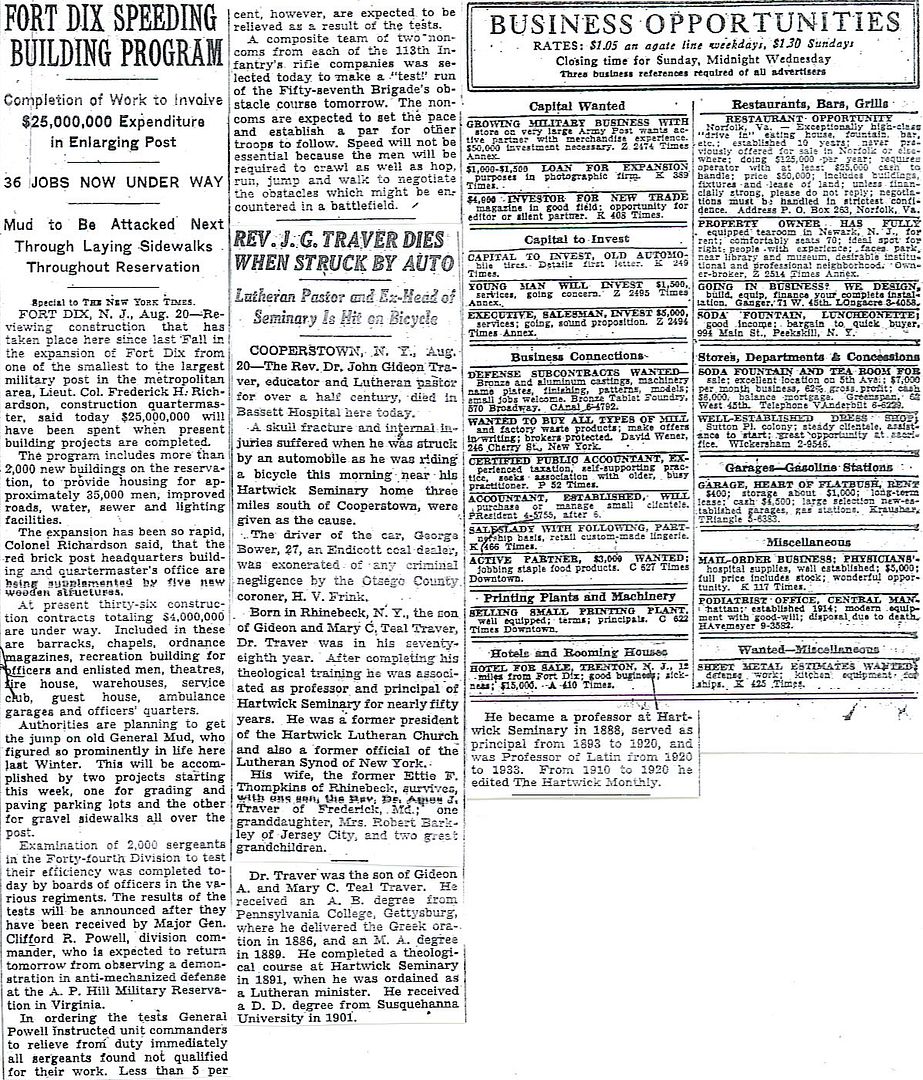
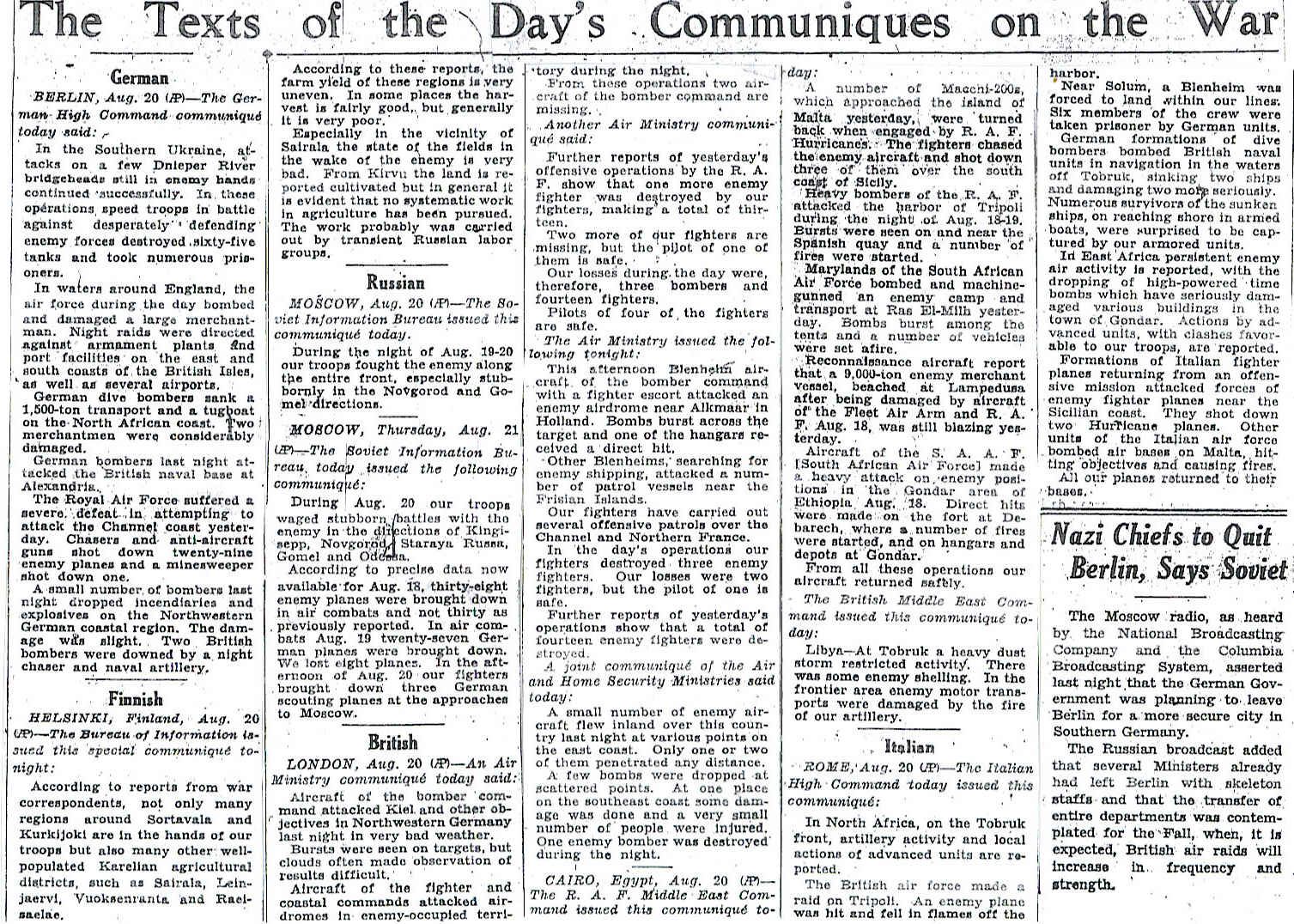
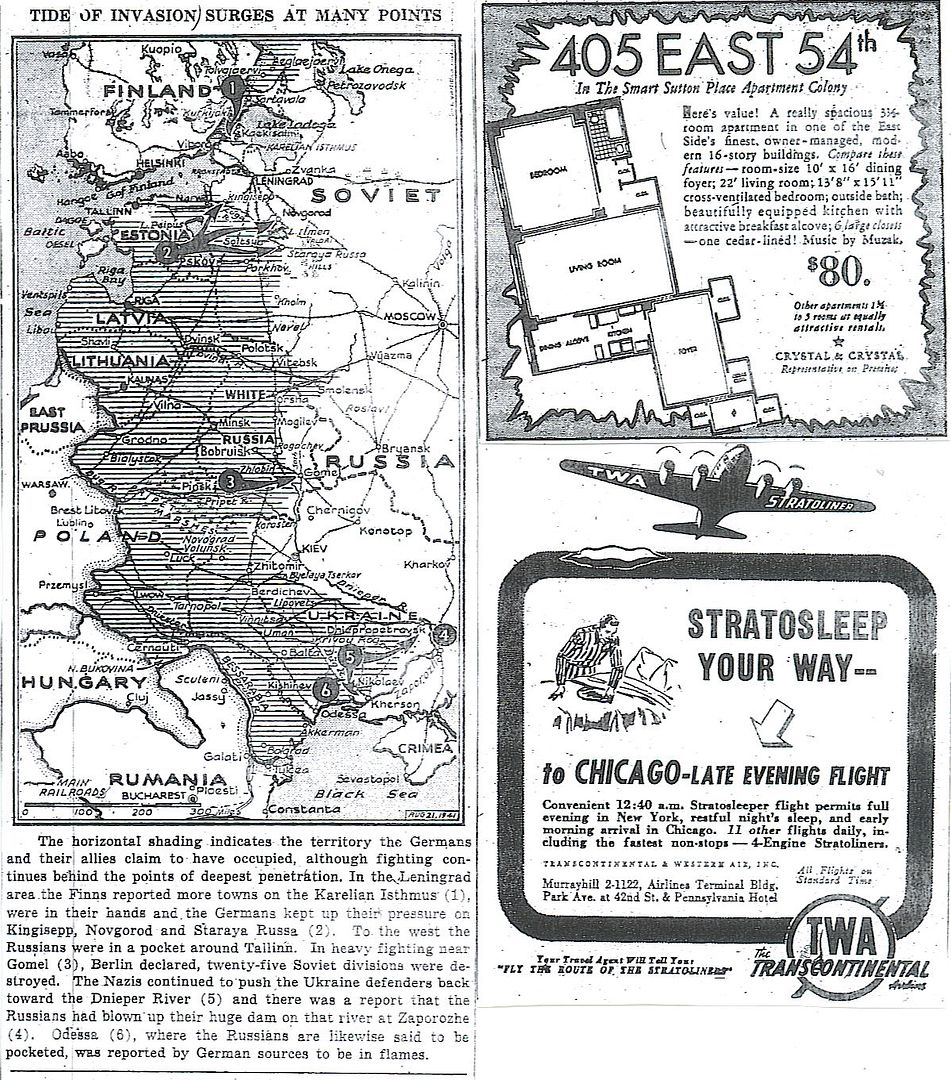
http://www.onwar.com/chrono/1941/aug41/f21aug41.htm
Germans advancing everywhere
Thursday, August 21, 1941 www.onwar.com
On the Eastern Front... In the north the Germans take Chudovo, northeast of Novgorod, cutting the main rail link between Leningrad and Moscow. In the Finnish attacks farther north Kexholm is taken form the Soviets. In the center the Soviets pull out of Gomel after a long struggle and a series of counterattacks. In the south the Germans take Kherson on the lower Dniepr River.
http://homepage.ntlworld.com/andrew.etherington/month/thismonth/21.htm
August 21st, 1941
EIRE: An RAF Hurricane Mk. IIB, s/n Z5070, which was on a delivery flight, makes a forced landing at Athboy, County Meath. This aircraft is repaired by the Irish Army Air Corps and becomes their sixth fighter aircraft in service; the six consist of three Gloster Gladiator Mk. Is, a biplane with a top speed of 253 mph (407 km/h), and three Hurricanes, two Mk. IIBs and a Mk. X. (Jack McKillop)
FRANCE: Paris: A German naval cadet by the name of Moser is shot in the Metro station of Barbès-Rochechouart by a young communist, Fabien who soon to assume the rank of colonel in the FTP.
Vichy arrests 5,000 Jews to be sent to Drancy concentration camp which opened yesterday. (Jack McKillop)
GERMANY: Herman Bernhard Ramcke who flew out to Crete in May to replace the dead Gen. Meindl receives the Knight’s Cross for his decision and subsequent leadership. As does Dr. Heinrich Neumann who took over command of I. Battalion Sturm Regiment. (Marc Rikmenspoel)
Adolf Hitler orders the investment, not capture, of Leningrad, and the transfer of several divisions from the North and Center to capture the Crimea and the Donets basin, an industrial region vital to the Soviet war effort.
U-174 launched. U-376, U-455 and U-584 commissioned. (Dave Shirlaw)
U.S.S.R.: Chudovo, NE of Novgorod falls to the Germans. This cuts the rail link between Leningrad and Moscow.
Finnish attacks capture Kexholm from the Soviets.
The Red Army retreats from Gomel after a long series of unsuccessful counterattacks against the Germans.
The Red Army blows up the Dnieper Dam to halt the German advance and as part of their “scorched-earth” policy. (Jack McKillop)
FINLAND: In southern Karelia IV Corps (Lt. Gen. Lennart Oesch) starts its attack today, one day earlier than originally planned. The Corps cosists of 12th ID (Col. Vihma), IR 25 and 8th ID (Col. Winell) with 4th ID (Col. Viljanen) in reserve. It is opposed by the three divisions of the Soviet 23rd Army (123rd, 43rd and 115th divs). The aim is to encircle and destroy the Soviet troops around Viipuri and western Karelian Isthmus.
The attack is originally planned for 22 Aug, but on the 21st it is found out that the Soviet troops are withdrawing along the whole front. The Finnish troops are ordered to immediately pursue the enemy. (Mikko Härmeinen)
CANADA: Minesweeper HMCS Grandmere launched Montreal, Province of Quebec. (Dave Shirlaw)
U.S.A.: President Franklin D. Roosevelt addresses the U.S. Congress about the Atlantic Chargers. He say, “Finally, the declaration of principles at this time presents a goal which is worth while for our type of civilization to seek. It is so clear cut that it is difficult to oppose in any major particular without automatically admitting a willingness to accept compromise with Nazism; or to agree to a world peace which would give to Nazism domination over large numbers of conquered nations. Over a week ago I held several important conferences at sea with the British Prime Minister.Because of the factor of safety to British, Canadian, and American ships, and their personnel, no prior announcement of these meetings could properly be made.” (Jack McKillop)
The motion picture “The Little Foxes” is released today. Based on the play by Lillian Hellman, this drama is directed by William Wyler and stars Bette Davis, Herbert Marshall, Teresa Wright (in her film debut), Richard Carlson and Dan Duryea (his film debut). The plot describes the greed and corruption within a crumbling Southern family. Regina (Davis) needs money to invest in a business with her brothers but her husband Horace (Marshall) refuses. Regina’s nephew Leo (Duryea) steals negotiable bonds from Horace’s bank to give the brothers, and when Regina tries to blackmail them, Horace claims the money was a gift. Furious, Regina withholds Horace’s medication knowing he will die without it and after he dies, she forces her brothers to give her two-thirds of their business. Her daughter Alexandra (Wright) learns what has happened and leaves her. The film is nominated for eight Academy Awards including Best Picture, Best Director (Wyler), Best Actress (Davis) and Best Supporting Actress (Wright). It does not win any awards. (Jack McKillop)
Submarine USS Gato launched. (Dave Shirlaw)
ATLANTIC OCEAN: The first Arctic convoy sets sail from Iceland to northern Russia.
"A concentration camp begins operations at Jasenovac, Croatia."
"Life in the ghettos in 1941 remained a torment for the residents, whom the Germans regularly mistreated.
Here, a German soldier dangles a Jewish woman in the Vilna (Lithuania) Ghetto by her hair.
Germans were taught not to think of the Jews as human, which made it easier for them to liquidate the ghettos once the death camps were established."
"Following their invasion of Yugoslavia, the Germans divided the country into several regions.
They placed Serbia and Banat under their direct control and initiated actions against the Jewish population.
In this photo, Jews from Zrenjanin in the Banat region prepare for deportation to the Tasmajdan concentration camp, near Belgrade, Yugoslavia.
There they would be executed.
In August of 1942, German leaders could proudly proclaim the area judenrein (cleansed of Jews)."
33 passengers and 5 crew members could fly NY to LA in pressurized comfort in one of 5 TWA Boeing 307s.
"Roosevelt-Churchill Program Omits Name of God, Meeting of Catholics Points Out"BUREAUCRACY HELD RISING
"Mrs. Roosevelt's Proposal for Drafting Women is Scored as 'Hideous'
"...Catholic Verein of America..." [Veterans?]
"...National Catholic Women's Union, who are holding their annual convention at the same time..."
" 'It is significant in this connection that in the recent past, since Russia transferred its alliance from one belligerent to another, liberty of religion was dropped from the list of liberties, the restoration and firm establishment of which had formerly been proclaimed a peace aim.'
"Domination by the Federal Government and the State to the detriment of the individual was scored in other resolutions..."
You just have to love the gentle women and men of these Catholic organizations, their hearts are truly in the right places.
But their levels of misinformation are mind-boggling to us today, and I fear may grow worse before becoming more realistic.
Boeing 307 - Is that what the Stratoliners were? Sounds pretty good. Board the red-eye in New York, put on your jammies, tuck yourself in bed, and wake up refreshed when you land in Chicago in the morning. Beats a packet of honey-roasted nuts any time.
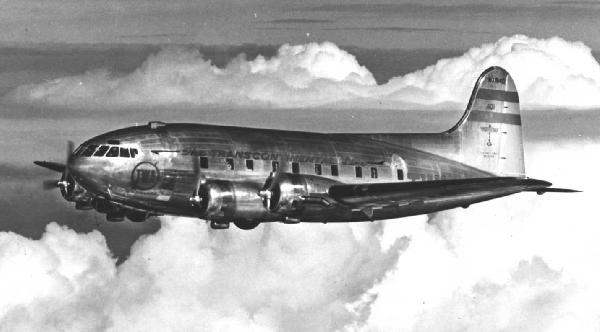
"Only ten Stratoliners were built. Three Stratoliners were built for Pan Am; five served with TWA, and a ninth Stratoliner was supplied to Howard Hughes. The prototype Boeing 307, NX 19901 crashed during a test flight."
The last working stratoliner, on display at the Aerospace Museum near Washington DC's Dulles Airport:
Guderian had been to see his 3rd and 4th Panzer Divisions which were trying to extend their bridgehead in order to continue their thrust to the south. But the troops were pinned down. He had also been to XLVI Corps, whose 10th Motorized Infantry Division and 17th and 18th Panzer Divisions were busy repelling fierce Soviet attacks from the flank. The situation there was not too rosy either. Too much was being demanded of the men. They were short of tanks and short of sleep.
Next to Guderian sat Lieutenant-Colonel Bayerlein, the situation map spread out on his knees. Thick red arrows and arcs on the map indicated the strong Russian forces in front of the German spearheads and along their flanks. " Yeremenko is going all out to reduce our bridgehead ," Guderian was thinking aloud. " If he succeeds in delaying us much longer, and if the Soviet High Command discovers what we are trying to do to Budennyy's Army Group, the whole splendid plan of our High Command could misfire ."
Bayerlein confirmed the anxieties of his Commander. "I was on the phone to Second Army yesterday. Freiherr von Weichs seems to be worried about it too. Lieutenant-Colonel Feyerabend, their chief of operations, has had reports from long-range reconnaissance about the Russians beginning to withdraw from the Dnieper front below Kiev. At the same time, work has been observed in progress on positions in the Donets area."
" Well, there you are." Guderian was getting heated. " Budennyy has learnt his lesson at Uman. He's slipping through the noose. Everything now depends on which of us is quicker."
But Guderian and Weichs need not have worried. True, Budennyy had realized the danger threatening his Army Group in the Dnieper bend around Kiev from a German thrust jointly from the north and the south. He had planned his withdrawal and was building up new lines of interception along the Donets. But Stalin would not hear of a withdrawal. On the contrary, he squeezed another twenty-eight major formations into the already packed river-bend. Whatever came off the assembly lines of the famous tank factories in Kharkov was thrown into the Dnieper bend—the modern T-34s, the T-28s, super-heavy self-propelled guns, heavy artillery, and multiple mortars.
"Not a step back. Hold out and, if necessary, die," was Stalin's order.
And Budennyy's Corps obeyed. Rundstedt's divisions on the northern wing of his Army Group soon discovered it. The experienced 98th Infantry Division from Franconia and the Sudetenland lost 78 officers and 2300 other ranks within eleven days of fighting for the key point of Korosten. The battle on the Desna between Guderian's and Yeremenko's divisions also went on for eight days. It was a terrible battle—a fierce struggle for every inch of ground. "A bloody boxing match," was Guderian's description. But then came the moment, a lucky accident exploited by a bold operation, when the tide was definitely turned against Budennyy.
In the afternoon of 3rd September the Intelligence officer of XXIV Panzer Corps placed a dirty and charred bundle of papers on the desk of his Corps commander, General Geyr von Schweppenburg. The papers came from the bag of a Soviet courier aircraft that had been shot down. Geyr read the translation, studied the map, and beamed. The papers clearly revealed the weak link between the Soviet Thirteenth and Twenty-first Armies. At once Geyr moved his 3rd Panzer Division against that gap. Guderian was informed by telephone.
The next morning Guderian turned up at Geyr's headquarters. It had taken him four and a half hours by car to cover the 48 miles: such was the condition of the roads after only a short rainfall. But he was cheered by the news awaiting him at Geyr's headquarters. General Model's 3rd Panzer Division had in fact driven into the gap in the Soviet lines. His tanks had torn open the flanks of the two Soviet Armies. As through a burst dam, the rifle regiments and artillery battalions were now spilling through to the south.
Guderian at once drove to Model. "This is our chance, Model." There was no need for him to add anything. Model's units were already racing to the Seym and towards Konotop in a headlong chase. Three days later, on 7th September, the advanced battalion of 3rd Panzer Division under Major Frank succeeded in crossing the Seym and establishing a bridgehead.
On 9th September the 4th Panzer Division likewise crossed the river. Stukas, supporting the experienced 35th Panzer Regiment and the 12th and 33rd Rifle Regiments, blasted the way for them through units of the Soviet Fortieth Army which had been freshly launched against the bridgehead. The Russians began to fall back.
Meanwhile Model's 6th Panzer Regiment was still outside Konotop. At the " Wolfsschanze " in East Prussia and in Bock's headquarters in Smolensk Guderian's headlong rush was being followed intently. It was important that Colonel-General von Kleist, down in the south, should be given his starting order at the right moment.
Major Frank had thrust past Konotop.
Army Group at once rang up Guderian: " Final order: drive towards Romny. Main pressure on the right." That meant that the pocket around Budennyy was to be closed in the Romny area. It was there that Guderian's and Kleist's tanks were to meet.
Romny had been the headquarters of King Charles XII of Sweden in December 1708; 93 miles away was Poltava, where Tsar Peter the Great inflicted a crushing defeat on the Swedes in 1709. The battle was the death-blow to Sweden's Nordic empire, and marked the emergence of Russia as a modern great power in history. Was this era now to come to an end again at Romny?
Everything went like clockwork. Guderian's tanks achieved the decisive breakthrough at Konotop. It was pouring with rain. But victory lent the troops new strength. The spearheads of 3rd Panzer Division were racing towards Romny. They were far in the rear of the enemy.
But where was Kleist? Where was the second prong of the vast pincers?
He had been held back wisely so that the Russians should not realize prematurely the disaster that was about to overtake them.
……To Be Continued……….
Hitler Moves East by Paul Carell
During their retreat in 1941 the Soviets, on Stalin's express order, had destroyed their technical miracle on the Dnieper. It was not to fall undamaged into German hands.
The dam was blown up and the shipping lock rendered useless. But either there had been no time for further destruction, or else what had been done was thought sufficient— the fact was that the power-station remained intact. However, an unlucky shell caused a serious fire and water burst into the machinery. As a result, the power-station was out of action for some time. However, after the first difficult repairs to the dam, generation of power was soon resumed. Even so it took yet another three years of laborious work before, early in 1943, power output was back to the old figure.
Not bad looking for a plane that’s gone for a swim.
Should have been about a 3 and a half hour flight. Not sure how refreshed you would be. (A little over 700 miles, a plane that cruises at a little over 200. With a range of 1700 miles, you wouldn't even need to stop in Chicago for gas. More likely refuel in KC and again in Albuquerque.)
Can't find a schedule for 1941. 1935 and 1945 here. http://www.airchive.com/html/timetable-and-route-maps/twa
Disclaimer: Opinions posted on Free Republic are those of the individual posters and do not necessarily represent the opinion of Free Republic or its management. All materials posted herein are protected by copyright law and the exemption for fair use of copyrighted works.